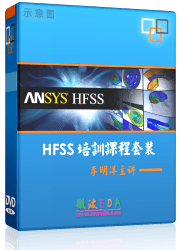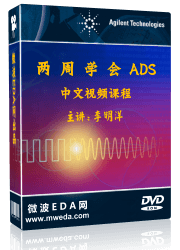|
 Ansoft Designer / Ansys Designer 在线帮助文档: Ansoft Designer / Ansys Designer 在线帮助文档:
Terms in Designer >
Glossary: C
Glossary: C
Capacitance
A measure of the ability of two adjacent conductors
separated by an insulator to hold a charge when a voltage differential
is applied between them. Capacitance is measured in units of Farads.
CDMA
Code division multiple access.
Cell Library
The collective name for the set of logic functions
defined by the manufacturer of an application-specific integrated circuit.
The designer decides which types of cells should be realized and connected
together to make the device perform its desired function.
Ceramic
An inorganic, nonmetallic material, such as alumina,
beryllia, steatite, or forsterite, which is fired at a high temperature
and is often used in electronics as a substrate or to create component
packages.
CGA (Column Grid Array)
A packaging technology similar to a pad grid array,
in which a device's external connections are arranged as an array of
conducting pads on the base of the package. However, in the case of
a column grid array, small columns of solder are attached to the conducting
pads.
Channel
(1)The area between two arrays of basic cells in a
channeled gate array. (2)The gap between the source and drain regions
in a MOS transistor.
Channeled Gate Array
Application-specific integrated circuit organized
as arrays of basic cells. The areas between the arrays are known as
channels.
Channel-Less Gate Array
Application-specific integrated circuit organized
as a single large array of basic cells. May also be referred to as a
"sea of cells" or a "sea of gates" device.
Checksum
The final cyclic-redundancy-check value stored in
a linear feedback shift register (or software equivalent). Also known
as a "signature" in the guided-probe variant of functional test.
Chip
Popular name for an integrated circuit.
Chip-On-Board (COB)
A process in which unpackaged integrated circuits
are physically and electrically attached to a circuit board, and are
then encapsulated with a "glob" of protective material such as epoxy.
Chip-On-Chip (COC)
A process in which unpackaged integrated circuits
are mounted on top of each other. Each die is very thin and it is possible
to have over a hundred dies forming a 3D cube.
Chip-On-Flex (COF)
Similar to chip-on-board (COC), except that the unpackaged
integrated circuits are attached to a flexible printed circuit.
Circuit Board
The generic name for a wide variety of interconnection
techniques, which include rigid, flexible, and rigid-flex boards in
single-sided, double-sided, multilayer, and discrete wired configurations.
CMOS
Logic gates constructed using both NMOS and PMOS transistors
connected in a complementary manner.
Coaxial Cable
A conductor in the form of a central wire surrounded
first by a dielectric (insulating) layer, and then by a conducting tube
which serves to shield the central wire from external interference.
Coefficient of Thermal Expansion
Defines the amount a material expands and contracts
due to changes in temperature. If materials with different coefficients
of thermal expansion are bonded together, changes in temperature will
cause shear forces at the interface between them.
Cofired Ceramic
A substrate formed from multiple layers of "green"
ceramic that are bonded together and fired at the same time.
Column Grid Array (CGA)
A packaging technology similar to a pad grid array,
in which a device's external connections are arranged as an array of
conducting pads on the base of the package. However, in the case of
a column grid array, small columns of solder are attached to the conducting
pads.
Combinatorial
A digital function whose output value is directly
related to the current combination of values on its inputs. Also known
as combinational.
Compiled Cell Technology
A technique used to create portions of a standard
cell application-specific integrated circuit. The masks used to create
components and interconnections are directly generated from Boolean
representations using a silicon compiler. May also be used to create
data-path functions and memory functions.
Complementary Output
Refers to a function with two outputs carrying complementary
logical values. One output is referred to as the true output and the
other as the complementary output.
Complex Programmable Logic Device (CPLD)
A device that contains a number of PLA or PAL functions
sharing a common programmable interconnection matrix.
Component
Components are items placed on schematics and layouts
to represent electrical elements and sub circuits. The component information
defines a signal-processing function or source, or secondarily a data
source, data channel, or similar entity. Components have pins for connections,
bitmaps in the project tree, and properties for simulation. The information
that constitutes a component includes its component chooser bitmap,
schematic symbol, layout footprint, pin properties, parameters and parameter
values, and netlist string definition. A component can be associated
with more than one simulation if it can be analyzed in more than one
simulator.
Computer-Generated Hologram (CGH)
Refers to a slice of quartz or similar material into
which three-dimensional patterns are cut using a laser. The angles of
the patterns cut into the quartz are precisely calculated for use in
the optical communication strategy known as holographic interconnect.
All of these calculations are performed by a computer, and the laser
used to cut the three-dimensional patterns into the quartz is also controlled
by a computer. Thus, the slice of quartz is referred to a computer-generated
hologram.
Conductive Ink Technology
A technique in which tracks are screen printed directly
onto the surface of a circuit board using a conductive ink.
Configurable Hardware
A product whose function may be customized once or
a very few times (see also Reconfigurable Hardware, Remotely Reconfigurable
Hardware, Dynamically Reconfigurable Hardware, and Virtual Hardware).
Conjunction
Propositions combined with an AND operator; for example,
"You have a parrot on your head AND you have a fish in your ear." The
result of a conjunction is true if all the propositions comprising that
conjunction are true.
Conversion Loss
The ratio in dB of the IF output of a mixer to the
RF input power. All conversion loss measurements and specification are
normally based on the mixer being terminated on all ports and a stated
LO signal power level being applied.
CPLD (Complex Programmable Logic Device)
A device that contains a number of PLA or PAL functions
sharing a common programmable interconnection matrix.
CRC (Cyclic Redundancy Check)
A calculation used to detect errors in data communications,
typically performed using a linear feedback shift register. Similar
calculations may be used for a variety of other purposes such as data
compression.
CSIC (Customer-Specific Integrated Circuit)
An alternative and possibly more accurate name for
an ASIC, but this term is rarely used in the industry and shows little
indication of finding favor with the masses.
Customer-Specific Integrated Circuit (CSIC)
An alternative and possibly more accurate name for
an ASIC, but this term is rarely used in the industry and shows little
indication of finding favor with the masses.
CVD (Chemical Vapor Deposition)
A process for growing thin films on a substrate, in
which a gas containing the required molecules is converted into a plasma
by heating it to extremely high temperatures using microwaves. The plasma
carries atoms to the surface of the substrate where they are attracted
to the crystalline structure of the substrate. This underlying structure
acts as a template. The new atoms continue to develop the structure
to build up a layer on the substrate's surface.
CVI (Chemical Vapor Infiltration)
A process similar to chemical vapor deposition (CVD)
but, in this case, the process commences by placing a crystalline powder
of the required substance in a mold. Additionally, thin posts, or columns,
can be pre-formed in the mold, and the powder can be deposited around
them. When exposed to the same plasma as used in the CVD technique,
the powder coalesces into a polycrystalline mass. After the CVI process
has been performed, the posts can be dissolved leaving holes through
the crystal for use in creating vias. CVI processes can produce layers
twice the thickness of those obtained using CVD techniques at a fraction
of the cost.
CW
Continuous wave; refers to an unmodulated sine-wave
signal.
Cyclic Redundancy Check (CRC)
A calculation used to detect errors in data communications,
typically performed using a linear feedback shift register. Similar
calculations may be used for a variety of other purposes such as data
compression.




HFSS视频教程
ADS视频教程
CST视频教程
Ansoft Designer 中文教程
|